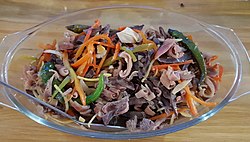  | |
| Course | main course, side dish |
|---|---|
| Place of origin | Philippines |
| Region or state | Visayas, Mindanao |
Paklay is two different Filipino braised dishes from the Mindanao and Visayas Islands characterized by julienned ingredients. They are eaten with rice or served as pulutan (side dishes) with alcohol.[1][2]
In Mindanao and Central and Eastern Visayas, it refers to a dish made from various beef, pork, or goat tripe with julienned ginger, bamboo shoots (labong), carrots, bell pepper, siling mahaba chilis and tomatoes, garlic, onions, and black pepper, among other ingredients. It is commonly slightly soured with fruits like pineapple, tamarind, or unripe starfruit.[1][3][4][5][6]
Among the Hiligaynon people of Western Visayas, on the other hand, it refers to sautéed bamboo shoots with fish or shrimp, tomatoes, ground pork or beef, onions, garlic, and other spices.[7]
See also[edit]
References[edit]
- ^ a b Reyes, Glady. "Paklay: Just Another Delicious Goat Dish". ExperienceNegros.com. Retrieved 18 October 2019.
- ^ "Paklay". Ang Sarap. Retrieved 18 October 2019.
- ^ "Paklay Recipe". Kusina Master Recipes. Retrieved 18 October 2019.
- ^ "RECIPE: Paklay ng Visayas". ABS-CBN News. Retrieved 18 October 2019.
- ^ Sison, Jainey. "Paklay ng Bisaya". Mama's Guide Recipes. Retrieved 18 October 2019.
- ^ "Paklay (Pork Meat and Innards Stew)". Panlasang Pinoy Meaty Recipes. Retrieved 18 October 2019.
- ^ "Paklay (Sauteed Bamboo Shoots)". Iloilo Food Trip. Retrieved 18 October 2019.

Well, that’s interesting to know that Psilotum nudum are known as whisk ferns. Psilotum nudum is the commoner species of the two. While the P. flaccidum is a rare species and is found in the tropical islands. Both the species are usually epiphytic in habit and grow upon tree ferns. These species may also be terrestrial and grow in humus or in the crevices of the rocks.
View the detailed Guide of Psilotum nudum: Detailed Study Of Psilotum Nudum (Whisk Fern), Classification, Anatomy, Reproduction